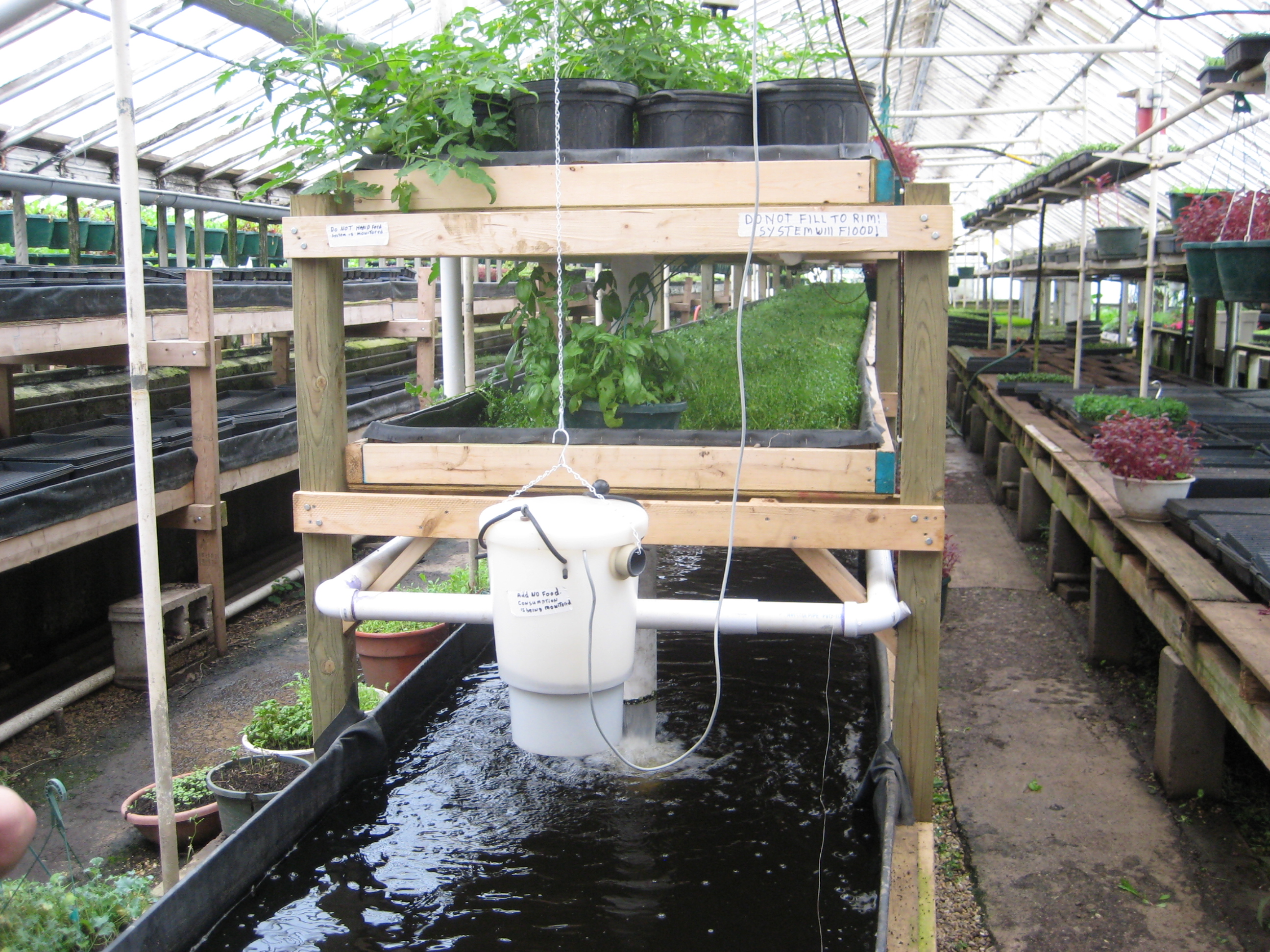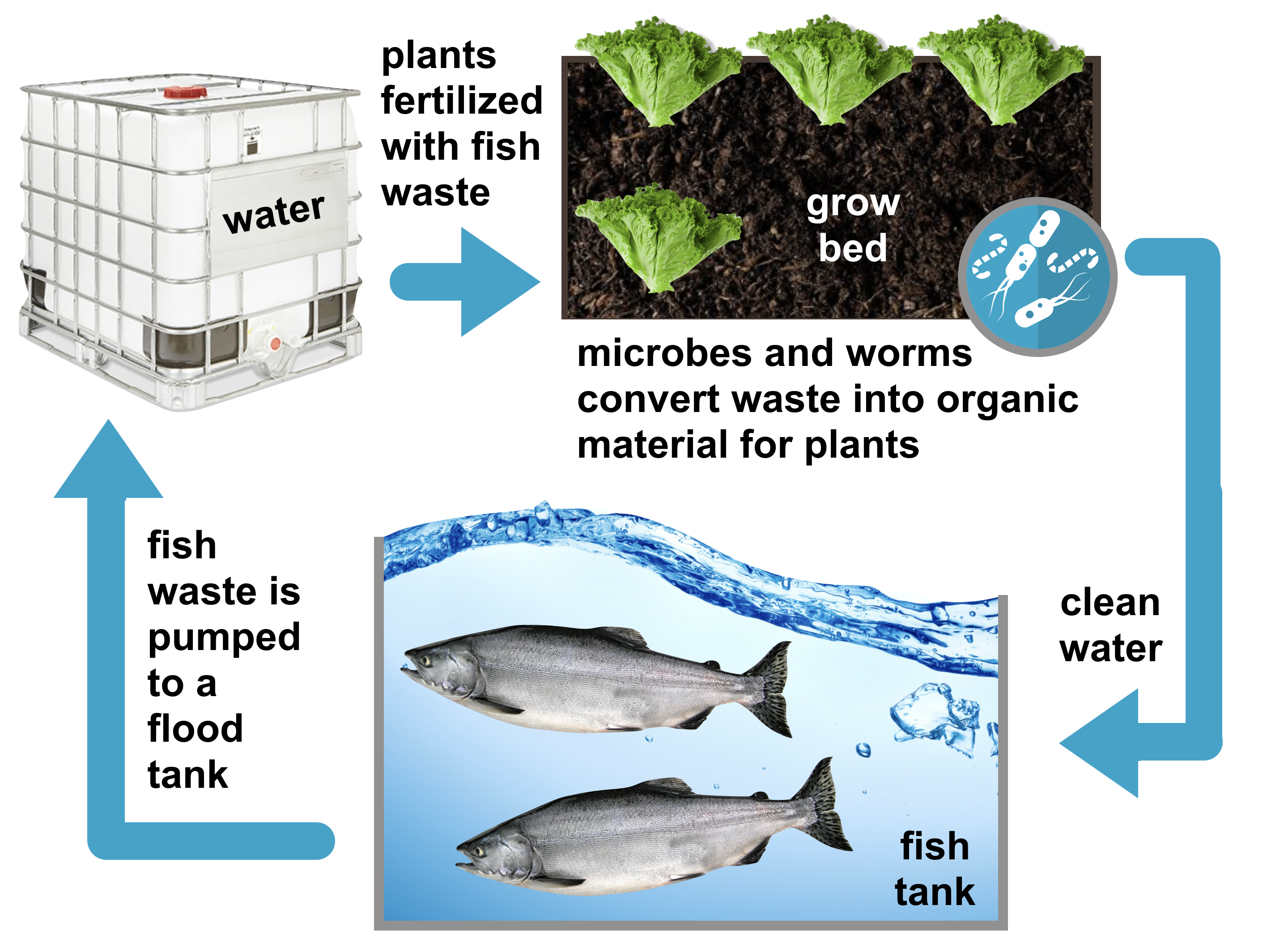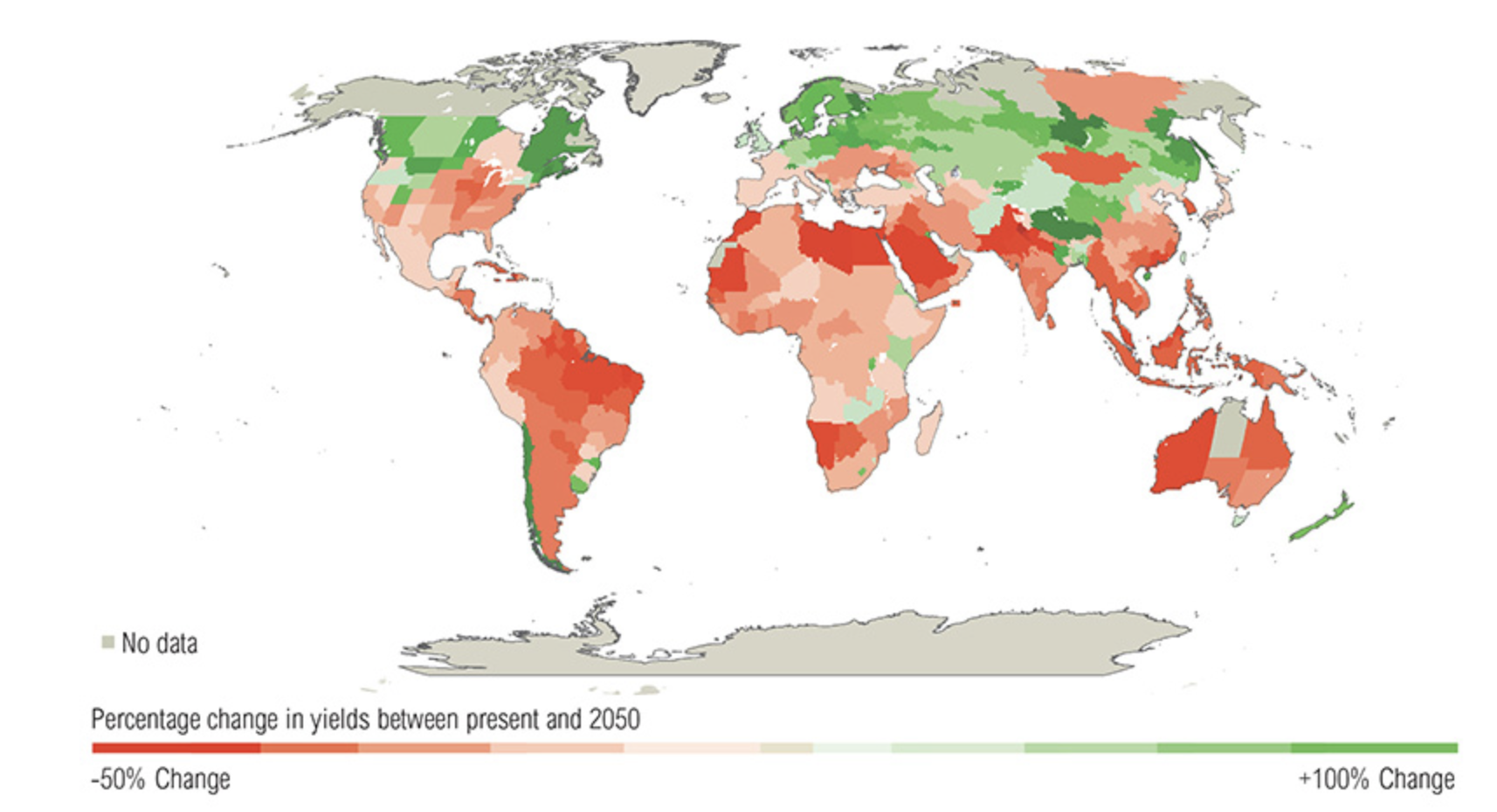Sustainability
5.3 Mitigating Climate Change and Increased Food Security Through Aquaponics Systems Technology
Sabrina C. Mazyck
Aquaponics is a hybrid food technology system that helps mitigate climate change through the combination of fish tanks and crops. As an alternative to both traditional agriculture and fish farming, might this technology be able to help feed urban populations? Does it have the potential to increase food security?

Courtesy of Ryan Griffis, 2008, FlickrCommons. CC BY-NC-SA 2.0.
The world is facing a number of serious problems. Population rise, climate change, soil degradation, water scarcity, and food security are arguably among the most important.2 Utilizing a new technology known as aquaponics could mitigate many of these issues.2 Clearing land for crops, artificial fertilizers, insecticides, herbicides, and larger livestock herds account for almost one quarter of anthropogenic, greenhouse gas (GHG) emissions.4 Sustainable agriculture is not a new phenomenon.7 It is the production of food, fiber, or other plant or animal products using farming techniques that protect the environment, public health, human communities, and animal welfare.7 This technique produces crops and raises animals without relying on toxic chemical pesticides, synthetic fertilizers, genetically modified seeds, or practices that degrade soil, water, or other natural resources. More specifically, aquaponics is a hybrid food technology system that has the potential to remove the negative environmental impact of current farming techniques. The name “aquaponics” derives from mixture of two words; aqua from aquaculture, which is the farming of aquatic organisms, and ponics from hydroponics, which uses water instead of soil to grow plants. It combines conventional aquaculture, or tank rearing of aquatic animals, with hydroponics, the growing of crops in nutrient-rich water.2,5,6 This system is a valuable alternative to both traditional agriculture, fishing, and fish farming. Its advantages include water conservation, sustainability, and the eliminated need for soil.
Figure 2. Variety of aquaponic systems.
System 1: This aquaponics system, located in a greenhouse, utilizes catfish and earthworms for plant production. Courtesy of Ryan Somma, 2008, Wikimedia Commons. CC BY-SA 2.0.
System 2: This aquaponics system is set up in a freshwater pond. Photograph by Saifullahrony, 2010, Wikimedia Commons. CC BY-SA 3.0.
System 3: Aquaponics systems can also be used residentially, like this backyard setup. Photograph by Vasch~nlwiki, 2013, Wikimedia Commons. CC BY-SA 4.0.
System 4: A vertical design is utilized in this aquaponic system at the Bangladesh Agricultural University. Photograph by BackyardAquaponics, 2011, Wikimedia Commons. Public Domain.
In an aquaponics system, fish and vegetables co-exist in a delicate, symbiotic cycle.5 Systems can be as small as a household aquarium with a tray of plants covering the top.1,6 Larger systems are often multilevel, recirculating aquaculture systems that incorporate the production of plants without soil.5,6 Recirculating systems are designed to raise large quantities of fish in relatively small volumes of water by treating the water to remove toxic waste products and then reusing it.5,6 In the process of reusing the water many times, non-toxic nutrients and organic matter accumulate.1,3,6 This waste water can then be channeled to support the production of secondary crops, providing further economic benefit to the primary fish production system.6 Dissolved metabolic by-products are recovered as nutrients by the plants, which allows for rapid growth, reduced discharge to the environment, and extended water use.1,6 Aquaponics can operate in more arid climates due to cost efficiencies gained by minimal water exchanges.6 This has the potential to save costs to people utilizing this system in places where space to grow food is generally unavailable.2,3 Urban areas which have large populations, require a great amount of food, and have limited space for production, will benefit immensely from aquaponics.2,3 Globally, this is important since only eleven percent of the Earth’s surface is ice-free land that produces food easily. Having a plant crop that receives most of its required nutrients at no additional cost improves a system’s profit potential.3,6 Fish feed, through ingestion and excretion, or decomposition, supplies a steady source of nutrients to plants, and thereby eliminates the need to remove, replace, or adjust nutrient solutions. Aquaponics systems achieve savings by requiring less water quality monitoring, less physical land, and the sharing of equipment such as pumps and heaters.6 The operational cost savings for commercial use would also be evident through elimination of insect and weed control.

Pesticides should not be used to control insects on aquaponic plant crops, as these pose a threat to fish.2,3,6,8 Also, antibiotics for treating fish parasites and diseases do not need to be used because vegetables have the ability to absorb them.2,6 This is appealing as the plants are grown without the use of genetically modified organisms (GMOs) or harmful chemicals that are present in many of the commonly consumed foods.8 The practice of adding salt to treat fish diseases or reduce nitrite toxicity is also detrimental to plant crops. Rising consumer demand for more organic products can be met with this technique.8 Non-chemical methods of pest management are the better option for the health of the human population as well as the environment.6 These include biological controls like resistant cultivars, predators, pathogens, antagonistic organisms, physical barriers, traps, and manipulation of the physical environment.6 There are more opportunities to use biological control methods in enclosed greenhouse environments than in exterior installations, like traditional farms, making aquaponics ideal for usage of these methods.6 Examples of non-chemical control includes parasitic wasps and ladybugs, which can be used to control white flies and aphids.6
In its current form, the agricultural and land use sector is an important contributor to climate change.4 However, agriculture contributing to climate change is a two-fold problem that has become a cyclical process as the human population increases. The worldwide agricultural sector sees itself affected by climate change.4 In the very near future, this may create challenges for the sufficient provision of food for the growing global population.4 Thus, there is a need for adaptive action, and agriculture should be an integral part of any global strategy for climate change mitigation.4 Agriculture is dependent on a wide range of ecosystem processes that support productivity including maintenance of soil quality and regulation of water quality and quantity. In developing countries, or places that are frequently and heavily affected by climate change issues, the use of aquaponics delivers a source of food that is unaffected by climate change. Agriculture vulnerability to climatic change is strongly dependent on the responses taken by humans to moderate the effects of climate change. Utilizing aquaponics systems could mitigate climate change and significantly add to increased food security to the benefit of people worldwide.

Courtesy of Janet Ranganathan, World Bank, 2013. Public Domain.
References:
- Ako, H., and Baker, A. (2009, October). Small-Scale Lettuce Production with Hydroponics or Aquaponics. College of Tropical Agriculture and Human Resources, University of Hawai‘i at Mānoa. Retrieved from http://www.ctahr.hawaii.edu/oc/freepubs/pdf/SA-2.pdf
- Goddek, S., et al. (2015). Challenges of Sustainable and Commercial Aquaponics, Sustainability, 7(4): 4199-4224.
- Jones, Scott. (2002). Evolution of Aquaponics. Aquaponics Journal, 6(1):14‐17.
- Kleinwetcher, U., et al. (2015). Global Food Efficiency of Climate Change Mitigation in Agriculture. International Institute for Applied Systems Analysis (IIASA).
- Matson, J. (2008, August). Angling for a Better Way to Farm Fish–And Vegetables, Too. Scientific American. Retrieved from http://www.scientificamerican.com/article/aquaponic-plants-and-fish/
- Rackocy, J.E., et al. (2006). Recirculating Aquaculture Tank Production Systems: Aquaponics—Integrating Fish and Plant Culture. Southern Regional Aquaculture Center, 454: 1-15. Retrieved from http://www.aces.edu/dept/fisheries/aquaculture/documents/309884-SRAC454.pdf
- United States Department of Agriculture. (2013, February). Climate Change and Agriculture in the United States: Effects and Adaptation.
- Whoriskey, P. (2015, April). Are these beautiful lettuce and tomatoes really organic? The debate over an agricultural innovation. The Washington Post. Retrieved from https://www.washingtonpost.com/news/wonk/wp/2015/04/24/theres-a-raging-debate-over-whether-these-types-of-lettuce-and-tomato-are-really-organic/.
Figures:
- BackyardAquaponics. (2011). [Photograph of vegetable growing part of the vertical backyard aquaponics system developed at Bangladesh Agricultural University]. Retrieved from Wikimedia Commons. Public Domain.
- BlackRiv. (2017). [Photograph of lettuce: used in graphic]. Retrieved from Pixabay. Public Domain.
- griffis, ryan. (2008). [Photograph of Growing Power, Milwaukee aquaponic system]. Retrieved from FlickrCommons. CC BY-NC-SA 2.0.
- Public Radio for Central Florida, WMFE. [Photograph of water: used in graphic]. Retrieved from http://www.wmfe.org.
- Ranganathan, Janet, World Bank, United Nations. (2013). The Global Food Challenge Explained in 18 Graphics. [Map of crop yields with 3 degree increase]. Retrieved from http://www.wri.org/blog/2013/12/global-food-challenge-explained-18-graphics.
- Saifullahrony. (2010). [Photograph of IMTA Systems in a freshwater pond]. Retrieved from Wikimedia Commons. CC BY-SA 3.0.
- Somma, Ryan. (2008). [Photograph of aquaponics system with catfish, plants above, and worms below]. Retrieved from Wikimedia Commons. CC BY-SA 2.0.
- Uline. [Photograph of water tank: used in graphic]. Retrieved from https://www.uline.com/BL_173/IBC-Tank?keywords=water+tank.
- Vasch~nlwiki. (2013). [Photograph of a backyard aquaponics system]. Retrieved from Wikimedia Commons. CC BY-SA 4.0.
- Washington Department of Fish and Wildlife. [Photograph of salmon: used in graphic]. Retrieved from http://wdfw.wa.gov. Public Domain.
